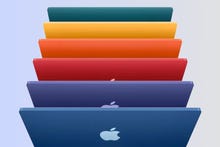
(Image: Shutterstock)
This week, following a report from Bloomberg, rumors have been swirling that Nvidia has been preparing to abandon its $40 billion-plus purchase of Arm Ltd., resulting from signals being sent by the Federal Trade Commission with its intent to stop the merger from proceeding late last year.
A merged Nvidia and Arm would have created a second potential semiconductor superpower behind Intel and a solid competitor to Qualcomm and Samsung in the mobile and embedded processor space — and a supplier of silicon for a next-generation of Arm-powered Windows laptops from Microsoft and other vendors.
So, many industry observers may be wondering: Is the future of Arm in desktop computing an all-Apple one? As it stands now, only Apple has found success with Arm-based silicon of its own design by transitioning its Mac platform to the M1.
Apple is in a clear lead with Arm-based desktops
Let’s be frank: Apple is so far ahead of the other companies when it comes to putting a desktop platform on Arm-based silicon it isn’t even funny. The M1 has now effectively been deployed across its entire Mac product line except the
Mac Pro
, and we know that’s coming shortly, including the first major chip revision in the form of the M2. The M1 Pro and the M1 Max are no slouches. I have been using one on a
MacBook Pro
for about a week, and let me tell you, there is no way I am going back to an Intel machine after experiencing performance like this. No way, no how. You’ll need to rip it out of my dying hands.
Admittedly, Qualcomm is making progress with SQ 2, and Microsoft has made Windows 11 run better on
Surface Pro X
. Still, we can’t compare what those two have done getting Windows working acceptably on a single product versus what Apple has done to make Apple Silicon work across its entire product line, never mind the iPad, the iPhone, the Watch, TV, all of it, and who knows what else it’s working on.
Surface Pro X is one device, but what about the entire PC industry? HP? Dell? Lenovo? Asus? Acer? Samsung? The first three alone occupy a 64% share of the personal computer market, whereas Apple is a whole 7.6%.
Those are pretty big numbers when you think of their PC market position compared to Apple.
Apple’s share is small when you compare it to the PC market as a whole; it’s only slightly larger than Acer’s, which is 7.2%. But here is the thing: A few years ago, if we were to make this observation, the numbers would look pretty similar. But, in 2022, there is a difference.
The divide in terms of shipped systems here is very stark and very clear — and Apple occupies a position that is not unlike the difference between Telsa as an automaker versus the rest of the car industry. Tesla has shipped more electric vehicles in a single year than the entire traditional automotive industry has shipped in 10 years.
Does Tesla represent a large part of the industry’s market share? In the US, it only occupies about 2.3% of the industry. But it has validated the technology for replacing the internal combustion vehicle. And Apple has done the same for the Arm architecture to eventually succeed x86.
As it was several years ago, Mac’s overall market share in business desktops remains relatively small, but now we see it has enormous potential, the power of the product is unassailable.
Today, all of us are saying, “Good lord, look what Apple pulled off.” The Arm desktop is real, the Arm is powerful, the x86 cannot top what this thing can do in terms of performance per watt. Just a few years ago, we had a different narrative.
Apple’s M1 is not a miracle; it’s a product of massive strategic investment
That Apple has achieved so much in what seems like a relatively short time is a testament to its investments going back over a decade in its own chips. Before Apple announced Apple Silicon as its future platform, the idea of using Arm chips as PC platforms was considered this theoretical, borderline future sci-fi thing.
We witnessed an early attempt at Windows on Arm with the Surface RT which failed in the marketplace and used an Nvidia Tegra 3 chip. It was slow, ran an incompatible version of Windows 8, and could not run legacy x86 Win32 apps other than what Microsoft pre-loaded and “Metro” apps from the recently-launched Windows Store.
It was certainly rumored for years that Apple was working on a successor to Intel for Macs. But Arm on a desktop OS really had not been put into practice unless you were an engineer at a company like Microsoft or Qualcomm and knew that in a lab, Windows ran well enough on the architecture, and yes, with a few years of work and billions of dollars of development, we might be able to replace x86 down the road.
We knew Windows ran OK headless as a server OS on special Qualcomm chips in Microsoft’s data centers, and some specialized Azure workloads ran on them. I saw this myself in demonstrations working with these companies behind the scenes when I was at the company.
But, as far as the typical business PC user was concerned, it was years — perhaps a decade — from being real.
The problem ultimately is not Windows’ readiness but overall silicon maturity. Windows not only works on Arm, but it screams if you run it in a Parallels window on a Mac and run native apps on it. Thus, Windows on Arm as an OS is ready, and Microsoft has all the developer toolsets to port apps if the silicon were ready across the PC OEM ecosystem tomorrow.
The emulated x86 apps now work much better on Windows 11 for Arm. But the Qualcomm SQ 2 is the only higher-performance Windows desktop chip on the block, and it is not even close to being as powerful as a first-generation M1. Never mind an M1 Pro or an M1 Max or whatever M-something we’re bound to see at the next Apple event when the Mac Mini refresh and whatever else is shown to us next.
The PC Arm silicon and system gap is a chasm that will take years to bridge
Currently, the leading Arm silicon vendor with a viable horse in the race — now that Nvidia has been knocked out of the running as a potential contender — is Qualcomm. Microsoft seems to have an exclusive on the company’s SQ series and appears to have no intention of licensing it out to the other OEMs, at least for now.
HP is testing the waters with the
Spectre
that competes with Surface Pro X. That laptop uses Qualcomm’s low-power, 4G LTE-enabled Snapdragon 7c Gen 2 compute platform, but it is no match for M1 or even SQ 2 in performance; it’s designed to compete with Pentium Silver.
Lenovo has the Yoga that uses the 5G-enabled Qualcomm 8cX; it was launched in 2020 and refreshed in February 2021. However, if you look at Lenovo’s CES announcements, there’s no Arm version of the Yoga announced for 2022; it’s a 100% Intel Evo and AMD Ryzen Playbook. So, I think sales were lousy on the Arm Yoga. The company is going with Intel’s low-power, energy-efficient Evo because the x86 is a proven architecture with predictable performance and industry confidence. Dell is also going with Evo, and HP’s mainstream low power notebooks are also Evo.
The 12-gen Intel Evo is good enough. It might not be the powerhouse M1, but it delivers good enough performance in terms of CPU and energy consumption with its advertised 9 hours of real-world battery life with a full HD display. Most mainstream business users will be happy with it.
Macbook Air M1
has about a 15-hour battery life. Its wattage draw scales between 18W and 110W depending on the application load, such as if you were crunching video in Final Cut or playing a very resource-intensive FPS game.
Like Apple Silicon, Evo is an SoC platform with WiFi6 built into it and GPU, with a 35 to 45-watt total system footprint. To be clear, this is a laptop roughly comparable to a low-end 2020 M1 Macbook Air in terms of functionality, but these Evo chips are nowhere near as powerful. We should probably mention the new AMD Ryzen 6000 platform for laptops, which is also an SoC platform getting much attention from PC manufacturers.
From a practical perspective, the only Arm game in town right now is Apple. Is Qualcomm going to make progress, sure, but that is a company that has its hands in a lot of different vertical industries and businesses. Qualcomm is a hugely profitable company in the embedded and wireless space; it doesn’t need to make desktop chips to make money.
The same can be said of Samsung Semiconductor as well. The South Korean electronics giant makes a massive amount of money minting chips for everyone, and although it has its own designs for its smartphones, tablets, and has a PC laptop business, it’s partnering with companies like Google and making their smartphone chips — as well as for Qualcomm and, yes, Apple. So, it doesn’t need to make desktop chips to be highly profitable either.
Is it a potentially significant expansion business for these two? Yes. Are desktop-level chips going to make them or break them? No. They can afford to take their time.
Can Arm on the PC desktop move forward?
Had Nvidia completed its purchase of Arm — assuming Bloomberg’s report is true, that it abandoned the deal — it would have been able to drive the future of the Arm architecture, including the core designs, and companies like Apple, Qualcomm, and Samsung would have licensed.
The merger/acquisition would have given it an edge in its own chip designs to create chips that eventually would have caught up to Apple Silicon. So now Nvidia has to go at it without those benefits. In place of this acquisition, it also looks like Softbank is going to IPO Arm, making it a public company. However, Arm without a large silicon manufacturer behind it is still a technology licensor.
I still believe that the business desktop has a next-generation future that is not tied to x86 PCs — but it might not take the form that we expect it to take. I firmly believe the business desktop’s ultimate destination is in the cloud, accessed by low-power, low-cost, solid-state, zero-configuration terminals running on minimal, embedded OSes, likely open-source ones. But that is an argument to be made in a future piece.
When do you think Windows and the PC will make the full Arm transition, if ever? Talk Back and Let Me Know.





